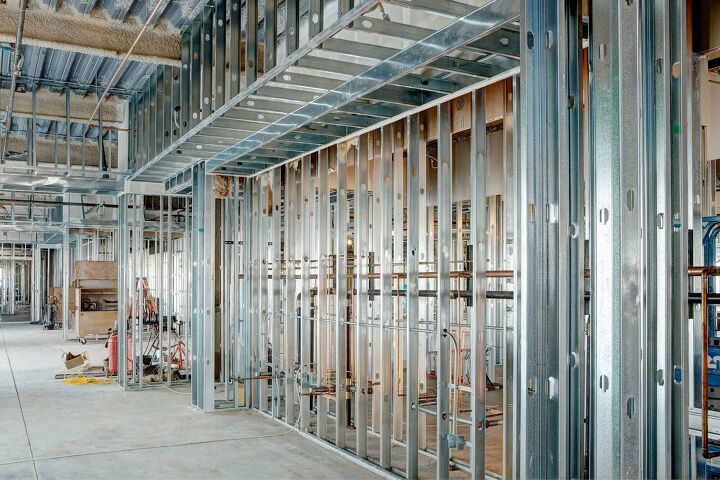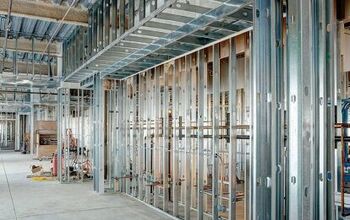How Do You Make Soffits For Metal Studs?

The roofing over a home or business is comprised of many different components. Though some are familiar to most, there are other components that only professionals tend to be familiar with. Those components are just as important to the equation as anything else even though they may not get the same level of conversation.
Soffits are necessary in your roofing, the word meaning “something fixed underneath.” How can you create one for metal studs? This guide will tell you everything that you need to know about soffits, studs, and everything in between.
Do You Need Metal Roofing Installation or Replacement?
Get free, zero-commitment quotes from pro contractors near you.

What is the Reason for Soffits?
The number one reason that you want to install soffits on your roof is that it provides proper ventilation. The soffit covers the underside of the roofing. Because it is on the underside, it also covers some of the attic space as well.
Heat can build up on the inside of your attic both from energy and heat rising within your house and the sun constantly beating down on your home. The soffit is meant to act as ventilation for the attic to filter some of that heat out.
When there isn’t that proper ventilation or quality airflow, the roof can actually become what is known as superheated. When your roof is superheated, the shingles can start to break down at a far faster rate and can even lead to ice dams forming come wintertime. All of this is bad for your roof and home as a whole.
Making a Soffit for Metal Studs
The trick is that you want to lay a track across the top of the ceiling. You can either screw or power nail it to the ceiling joists so that it is secured. After that, you simply run a track horizontally so that it is along the back vertical wall so that it can become the soffit’s lower backside edge.
Tack a piece of that track and cut completely through the middle of it using a jigsaw that has a special metal cutting blade attached. You want it to form a pair of 90-degree angles. Make sure to cut the studs so that they form your vertical runners and make them to be as long as the soffit will be deep.
After Making the Cut
When you’ve cut them properly, press-fit them into your ceiling track. You can press them in however far apart you want the studs to be spaced. From here, you will take a stud that is meant to form the bottom of your soffit and cut it down to length.
You will screw the front edge of your stud into the vertical studs’ bottom edge; this will form an “L” shape on that side. Push the stud snugly into the horizontal track and then properly secure the top stud to the ceiling track or it will eventually fall out due to the weight.
Repeat this step for every stud section. Make certain that all of the joins are square and consistent in their dimensions. When they’re done, take the angle iron and run it all across the bottom part of your front soffit’s edge. This is the point where the drywall edges will join up, giving you something to properly screw into.
Can You Anchor to Metal Studs?
If you have items that are lightweight, they can be anchored directly into the drywall. There are a number of different anchors that are used so that you can easily secure an object to the drywall instead of having to get down into the stud.
For heavier items, it is recommended that you drill into the stud itself. There are special bits that you can get that are meant to drill into metal studs. It depends on the quality of the drywall and the weight of the item that you are hanging.
Are Metal Studs Load Bearing?
Generally speaking, your heavier gauge metal wall studs can and will be used in not only load-bearing walls, but in structural applications like exterior walls. The lighter gauge metal studs are typically used on things like half-walls, partitions, and interior walls where there is no load-bearing.
The good thing about metal studs is that they are available in many of the same sizes and dimensions as your typical wood studs. This allows you to get the proper metal studs for your wall with relative ease, oftentimes at the local hardware store.
How Much Weight Can You Hang on Metal Studs?
There is no set determination for how much weight that a metal stud can take on. The load weight limit of a stud is also known as the axial limit. There are some, like an 8-foot, 3 ½ inch metal stud that can support as much as 2,000 pounds. Meanwhile, a 16-foot stud that has the same width may only support 400 pounds.
It is important to do your research before you decide on a stud to know what kind of axial load it can handle. After all, the last thing that you want is to mount something to your metal stud only for it to come tumbling down and bring the drywall with it.
Are Metal Studs More Expensive?
Generally speaking, yes, metal studs are more expensive than their wooden counterparts. Times have changed, however, and now the cost disparity has been mitigated substantially. In most cases, you can find metal studs that are only 30% more expensive than their wooden counterparts.
The investment in quality is another thing to consider when going with metal versus wood. Metal studs are impervious to termites, fire, splitting, rot, and just about any of the other hazards that can plague wood studs.
Wood may always be the more cost-effective route, but with the cost gap closing, it may be a much smarter investment to go with metal studs.
How Far Apart Do Metal Studs Need to Be?
It is always ideal to have a stud finder on you to do the job. But let’s say that you don’t and need to determine how far apart your studs need to be placed. When framing a home, the wall studs will generally be around 16-24 inches apart.
Start in a corner and measure out 16 inches; if you don’t find a stud, continue to the 24-inch mark and you should find one there. More often than not, this rule should help you to locate studs in an existing wall with relative ease.
Do You Need Metal Roofing Installation or Replacement?
Get free, zero-commitment quotes from pro contractors near you.

What Kind of Screws are Used for Metal Studs?
One thing to be aware of is that you can’t use just any old screw to mount something like drywall to steel studs. You’ll want to make use of fine drywall screws on studs that have a 20-25-gauge rating. Anything less than 20-gauge and you’ll want self-drilling drywall screws.
The latter are constructed with shaper tips than you would normally find, and the threads are created finer to prevent stripping in metal. The finer threads also tend to grip to metal much better than your standard-thread screws.
It is important that you use the right types of screw-on metal studs. If you don’t, the screw can get stripped out and lose its strength.

Ryan Womeldorf has more than a decade of experience writing. He loves to blog about construction, plumbing, and other home topics. Ryan also loves hockey and a lifelong Buffalo sports fan.
More by Ryan Womeldorf



























